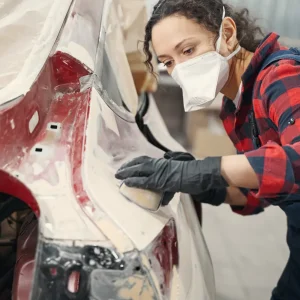The BusinessCar Awards celebrate the best-performing companies in the industry, according to the people best qualified to assess them: the customers themselves. And there was one service provider that impressed more drivers than any other, winning no fewer than four awards: the AA.
Chalking up the Service Supplier of the Year title, as well as the Accident Management, Vehicle Recovery and Risk Management gongs, the AA proved that it can cope with the demands of a challenging industry. And the key to this, according to Roger Williams, the organisation’s director of business services, fleet, is the relationship that the brand manages to build with drivers.
“Being broken down is horrible, isn’t it? And then someone turns up and fixes your car. So I think people have quite a personal relationship with us,” Williams muses, with the company attending around 10,000 call-outs per day and fixing about 80% of these vehicles.
“We’ve been very committed to fleet over a long period and I think that, hopefully, the market is aware of that,” Williams continues. Another factor contributing to the AA’s strong performance, he adds, is that it has a large fleet itself, with more than 3000 of its own vehicles, “which I think helps us to understand what fleet operators are looking for”.
The AA is going through a “period of transformation”, according to Williams, with the ambition of becoming a more digital operation than it has been previously. Part of this involves a push to modernise the experience that customers have with the business, he says, dealing with them in a more efficient, user-friendly way online.
Expansion
Aside from providing roadside assistance, Williams believes the fact the organisation offers so many other complementary services contributes to its appeal as a fleet service provider: “We do want to expand, we do want to grow the business, but we want to do it with products that are relevant and, hopefully, at some point support the core business, which is the breakdown business.”
Areas for growth vary from boosting the provision of breakdown services at the roadside to insurance ventures and developing new remote repair services.
“I think it’s fair to say that anything we do for consumers generally has a business application,” states Williams, with services such as Key Assist, where the company cuts and reprogrammes car keys on the spot, and Fuel Assist – where the firm siphons off fuel from misfuelled vehicles – being elements the AA is “looking to grow”.
Accident management also offers plenty of scope for the AA to develop as a business. “There’s a lot of change going on in the accident management market, but there is definitely a link into breakdown; the ability we have to deploy a resource to an accident is actually quite reassuring from a customer point of view,” says Williams, adding: “It’s a market that we very much want to be in.”
Despite speculation over whether BusinessCar Risk Management Award-winning AA Drive Tech will stay under the AA umbrella, Williams is keen to stress that “as far as we’re concerned, it’s remaining part of the AA”, following a business review of the division. As with other AA businesses, the organisation is looking to grow the scale of the operation: “There’s two sides to that [growth]: there’s a fleet side – so pushing more products into the fleet market – and also making sure we get more police contracts, as we are the provider of speed-awareness courses for certain police authorities.”
Another new area for the AA is financial services, following a joint-venture with Bank of Ireland, says Williams, with the company now underwriting its own insurance policies, rather than solely being a broker as it has been in the past.
Also high on the AA’s list of priorities is the vehicle inspections arm, where the company assesses the condition of cars before sale. “We’ve already got some pretty decent-size relationships in that space – checking vehicles through auctions – and that’s something we’re looking to do more of,” Williams comments. “That could be anything from a 15-minute check of the basics through to a proper inspection.”
While AA Tyres is very much a consumer venture currently, it is possible that the AA could target it at fleets “in the fullness of time”, once it has established nationwide coverage, muses Williams.
There is scope to offer more tailored services to fleets of different sizes to win new fleet customers too, Williams states: “We deal with everything from a two-car SME through to [the UK’s largest leasing company] Lex. At the bottom-end there are lots of smaller companies, and I think packaging things up that would be relevant to them but that maybe aren’t over-engineered – and almost having a sector-by-sector approach – are things that we’re looking at, at the moment.”
New projects
Not only did the AA win a three-year deal in January to provide roadside assistance, recovery, incident management and European breakdown cover to Lex and its 307,000-vehicle strong fleet, but 68% of new vehicles come with AA cover, states Williams, cementing the brand’s position as the biggest name for roadside assistance. “We also deal with some very fleet-relevant manufacturers,” Williams says. “Ford, Vauxhall and the Volkswagen Audi Group are key vehicles in most fleet profiles.”
The company has updated its telematics offering, too, launching AA Fleet Intelligence – in conjunction with Trakm8 – at the start of the year, which in the case of the AA’s own fleet tracks when vehicle beacons are on and extendable trailers deployed. The company is using its position as a recovery service to monitor fleet driver profiles and accident rates and see how it aligns with breakdown figures, “because, generally if someone is not a very good driver they tend to have more breakdowns”, says Williams.
The AA is also taking telematics data from five manufacturers to help with “breakdown diagnosis on a technical level”.
Other moves to boost customer service levels include issuing rugged Panasonic tablets to patrols, which is due to be complete in June. These are quicker for drivers to work with, according to Williams, allowing them to fill in forms digitally and send them electronically to motorists, “which I think from a fleet point of view is quite useful”.
Patrols have also been issued with iPhone 6s, which Williams claims will help save additional time, with staff able to do around 80% of their jobs on the phone, without having to fish the tablet out.
Meanwhile, the company has invested £5m in new Bosch diagnostic kit, which has seen repair rates jump by around 1%, “which doesn’t sound like much, but actually across 3.5 million breakdowns that is a lot”, Williams states. This is thanks to more precise diagnosis of mechanical issues, meaning that patrols can make more accurate decisions about whether they are able to repair cars at the roadside.
The AA is also in the process of introducing a universal spare tyre, which fits models with different hub formats, to enable drivers of the increasing number of vehicles that don’t include a spare tyre to keep driving to a garage to purchase a new tyre, should they experience a puncture. The rollout of this should be complete in summer, claims Williams.
Another new tool in the AA’s arsenal comes in the form of a new ‘compact recovery trailer’, which deploys from the back of the company’s vans and is lighter and quicker to deploy than before, and adds the ability to carry motorbikes.
Additionally, the capacity to enact remote repairs could also change the way the AA does business, Williams says: “There are certain jobs that can be done remotely. But then you’ve got to be very careful that you’re doing it safely.”
Williams cites the example of diesel particulate filter regeneration, where a diesel motor is run at high engine speeds for around 10 minutes to clean the filter. In this case, as the exhaust can get very hot, it introduces the risk of fire if there’s anything flammable underneath the vehicle, and thus necessitates that a patrol is present to ensure safety.
However, this type of remote repair is something that the AA is “doing loads of work on” to establish viability.
Apps
The AA now boasts a number of its own app offerings, which let drivers do everything from reporting a breakdown instantly to locating nearby parking, hotels and restaurants.
One “exciting” development of the main AA app, according to Roger Williams, AA director business services, fleet, is that “the latest version allows you to not only register a breakdown, but you can basically, without speaking to anybody, call a patrol out”, ensuring that a van sets off as quickly as possible.
Williams continues: “The neat thing is that you can track the patrol’s progress to you, which is quite reassuring if you’re sat by the side of the road thinking, ‘I wonder where they are?'”
This is currently in use for AA personal members, claims the AA boss, with vans alerted to 11% of breakdowns through the app at the moment. “It does save a little bit of time in terms of the total length of the job,” says Williams. These time savings may be small but, as he adds, “clearly there’s some efficiency to be gained there”.
The breakdown service also has a number of B2B-specific products, says Williams, with fleets able to use the AA Cars online viewing portal to see any repairs that are currently being undertaken on their vehicles and establish exactly where broken-down vehicles have been recovered to in real-time.





